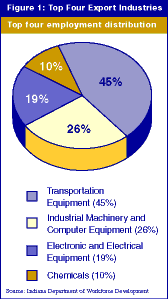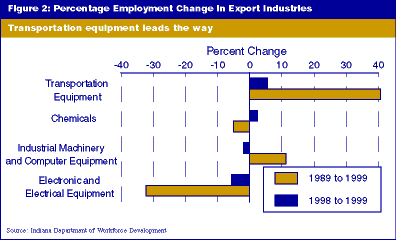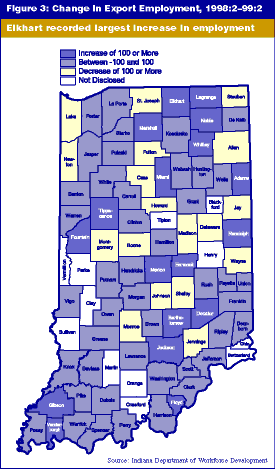Exporting Industries: Employment and Wage Trends
Indiana's top four export industries—transportation equipment, chemicals, machinery and electronics—together accounted for 10% of the state's employment and almost 16% of the state's wages, according to covered employment and wage data for second quarter 1999. (For details on exports by industry, see IN the Spotlight.)
Higher Wages Across the Board
Average weekly wages for the four export industries were all higher than the overall average weekly wage of $559 for the state. The highest average weekly wage, $1,330 per week, was in the chemicals industry. This wage is 2.4 times the state average. Together, the four top exporting industries paid, on average, $885 per week, one and a half times greater than the state average.
Each of the four largest export industries paid higher wages in 1999 than in 1989. In average weekly wages, the greatest increase was in the chemical industry (84%), followed by transportation equipment (44%), industrial machinery (34%) and electronics (32%).
Click on table to see larger version.

Employment Changes Unique for Each Industry
While each of the top export industries show wage increases, changes in employment vary according to the industry. Figure 1 shows the contribution to total employment by each of the four industries in second quarter 1999. Looking at changes in employment in the most recent year and in the past 10 years for the four industries reveals four different scenarios.

Figure 2 shows the percent change in employment for each of the four sectors, from second quarter 1998 to second quarter 1999, and from second quarter 1989 to second quarter 1999.

Motor vehicles and equipment account for the largest portion of employment in the state's transportation equipment industry. Employment in this industry grew from 90,700 in 1989 to 120,800 in 1998. In the last year covered by the data, an additional 6,800 jobs were created within the industry. The net increase over 10 years has been 36,900 jobs, with 18% of the increase occurring in the most recent year. The addition of the Toyota plant in Princeton and the Chrysler expansions have contributed to employment growth in this sector.
Pharmaceutical preparations account for the largest portion of employment in the chemicals industry in the state. The chemicals industry has seen a decrease in employment in the past 10 years, but employment grew by 700 in the most recent year. Employment growth in this industry is expected as Eli Lilly continues its expansion.
The industrial and commercial machinery industry includes industrial machinery, metalworking machinery, and engines and turbines. The last year saw a decline in employment of 1,500 jobs. However, including last year, net employment in this industry increased by 7,700 over 10 years.
The electronic and electrical equipment industry includes electronic components and accessories, electric lighting and wiring equipment, household appliances, and household audio and video equipment. Employment declined by 32% from 80,000 in 1989 to 54,100 in 1999. Employment declined by 3,300 in the most recent year. Downsizing and closures of manufacturing plants including GE and Thomson Consumer Electronics have contributed to employment decline in this sector.
Figure 3 (click on map to see larger version) shows the change in combined employment for the four export industries between second quarter 1998 and second quarter 1999, by county. Elkhart County recorded the largest increase in employment (2,588), followed by Gibson (861), Marshall (695), Decatur (657) and Tippecanoe (643). Counties recording the largest decreases in employment were Madison (742), Delaware (703), St. Joseph (701), Shelby (604) and Allen (524).
Overall, the comparison of export and employment data shows how complex the Indiana and global economy have become. In today's economy, a shrinking industry in terms of employment may in fact be expanding in terms of exports that add wealth to the Indiana economy.
Technical Note:
Employment change in some sectors is due in part to reclassification of certain types of establishments. In electronics, for example, establishments with more than 5,000 jobs were shifted from the electronics to the transportation equipment classification. Similarly, in 1999 at least one major employer was shifted from industrial machinery to primary metals

